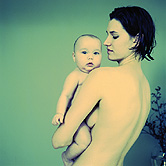Why Carrying Your Baby Calms Him
This quieting effect is an evolutionary win-win, study finds.
The best place for a crying baby is in its mother's arms, researchers suggest.

When fretful babies are picked up and carried by their mothers they experience an automatic calming reaction.
This evolutionary effect, seen in both mice and people, reflects a coordinated set of central, motor and cardiac regulations, according to the study.
It also could help explain why calm babies start crying as soon as they are put down. This insight could help ease parents' frustration and help prevent child abuse, the researchers said.
"From humans to mice, mammalian infants become calm and relaxed when they are carried by their mother. This infant response reduces the maternal burden of carrying and is beneficial for both the mother and the infant.
When babies are in their mother's arms, they have a greater chance for survival, the researchers said. Meanwhile, mothers prefer to have calm and relaxed babies. It's a win-win for moms and their babies, the researchers said.
In studying the response of human babies when carried by their mothers, the researchers found that their heart rates slowed immediately when they were picked up. They also stopped moving. Using tiny heart monitor electrodes, the same response was found among mice. The ultrasonic cries of baby mice stopped as well.
The study authors said certain areas of the brain and nervous system are essential to coordinating this response to being carried.
The findings are very relevant to parenting and may play a role in the development of strategies to prevent child abuse, the researchers said. Understanding crying from a baby's perspective might ease their frustration, they said. When parents are less frustrated, child abuse may be less likely to occur.
A scientific understanding of this infant response will save parents from misreading the restart of crying as the intention of the infant to control the parents, as some parenting theories -- such as the 'cry it out' type of strategy -- suggest. Rather, this phenomenon should be interpreted as a natural consequence of the infant sensorimotor systems.
Source: HealthDay News
- 380 reads
Human Rights
Fostering a More Humane World: The 28th Eurasian Economic Summi

Conscience, Hope, and Action: Keys to Global Peace and Sustainability

Ringing FOWPAL’s Peace Bell for the World:Nobel Peace Prize Laureates’ Visions and Actions

Protecting the World’s Cultural Diversity for a Sustainable Future

Puppet Show I International Friendship Day 2020

